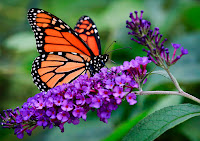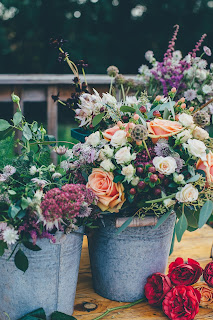We have all heard about the decline in pollinators and the real-world implications are truly frightening. But what can one person do? Plenty, as it turns out. Make the commitment to support pollinators in your own small part of the world – your yard or garden. It only takes a few thoughtfully considered steps to turn your space in a pollinators’ haven.
 |
| A hummer at rest - a rare site |

Go Native: Native species are incredibly important to any healthy pollinator habitat; let’s encourage them.
• Seek plants that are native to your area. This does not mean that you need to research the botanical roots of each plant you have and then rip up and replace the ones that have origins elsewhere. Many plants have been here long enough for the local pollinators to have adapted to them. The Camelia is a good example of this. This flower was first introduced to North America in 1797, but is now fully accepted and loved by our native insects.
• Avoid flowers that have been bred to have double blooms. These varieties are undoubtedly beautiful but have less pollen and what they do have is harder to access.
• Don’t forget night-blooming flowers for those nocturnal pollinators - moths and bats.
• Plant Milkweed for the Monarchs. This native plant is crucial to the survival of these beautiful butterflies and it is quickly disappearing in the wild. Many other pollinators appreciate it as well. Two good reasons to plant it.
 • Still not sure what to choose? There are excellent lists available to help you choose the perfect pollinator-friendly plant to add to your garden.
• Still not sure what to choose? There are excellent lists available to help you choose the perfect pollinator-friendly plant to add to your garden. Think Long Term:
Think Long Term:To attract and keep pollinators in your yard, you need to create a constant source of pollen and nectar.
• Native bees need to feed for months; plants that bloom just once (no matter how spectacularly) offer very little for these insects.
• Throughout the growing season (spring to late fall), aim to have something bloom every week.Think variety to make your garden more attractive to a larger number of pollinators and more interesting visually.
Look Up: When considering planting for pollinators, look at trees.
• Not all pollinators are found close to the ground, many trees harbor and nurture butterflies and other pollinators.
 • Oak trees can support 500 different species of butterflies and moths; for most common flowering perennials that number would be in the dozens at most.
• Oak trees can support 500 different species of butterflies and moths; for most common flowering perennials that number would be in the dozens at most.Herbs Are Great: Herb gardens are especially attractive to bees, butterflies and hummingbirds.
• Many popular herbs (dill, parsley, basil) are imports, but they are closely related to native herbs. This genetic similarity makes them eminently acceptable for our native bugs.
• For maximum pollinator effect, only snip off half your plants. Allow the other half to flower. In otherwise, share the goodness.
• Planting an herb garden is a no-brainer; even if you can’t lure pollinators to it you can enjoy its bounty yourself.
Don’t Over-groom: What you see as messy-looking is appealing to the creatures that fly and crawl.
• Let plants wander and bloom at will. All the nooks and crannies create habitat or hiding places for our helpful insect partners.
• Re-think weeds. Blooming weeds and wildflowers are the natural lifeline for native pollinators in the months following spring blossoms. Weeds may be unsightly to you, but they are highly desirous to a hungry insect. One option is to simply allow some weeds to flourish on the edge of your carefully cultivated space.
• Leave some debris around to give native bees a place to nest. One dead limb is an excellent bee condo.
 Let’s Look At Lawns:
Let’s Look At Lawns:Lawns are the number one irrigated crop in America, which is problematic.
• Lawns don’t provide food and offer very little to pollinators and wildlife in general. All good reasons to reduce our attachment to them.
• If you are not ready to give up your lawn completely, try giving up a little bit around the edges and see how that feels. A slightly larger flower bed or a border around a sidewalk or driveway can be filled with lovely flowers. You’ll use less water and make our pollinators happy.
• You could also transition some of your lawn to a cover crop. There are a number that make a lovely mat of low lying foliage and many (like the clovers) are flower-filled and beloved by pollinators.
There are many other things that can be helpful in building a pollinator friendly garden, such as providing water or a salt lick. Providing water can be as easy as finding plants that capture rainfall. Or build something; here are instructions for an easy water feature and here is a short video on salt licks.
In my research for this article, I came across the Million Pollinator Garden Challenge. They are doing some really cool stuff and I encourage everyone to join their movement. Or start your own movement right at home.
Paul Stametts, an American mycologist and author, has an interesting theory on how certain fungi can help bring our bees back to a healthy population. Here is a 10 minute clip that explains this further.
On another note: The big news this week was the fire at Notre Dame cathedral. From what I’ve read, they were able to save many (if not most) of the treasures that were inside. Another form of treasure also managed to make it out of the fire – their bees. It seems that there were three hives on the roof that miraculously survived. Read all about it here. Enjoy – it’s heartwarming.
Submitted by Pam








No comments:
Post a Comment